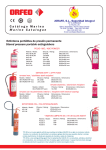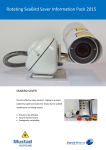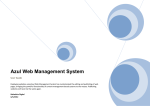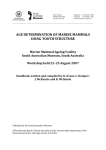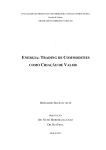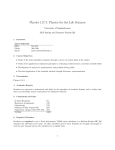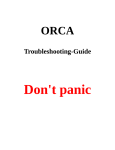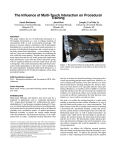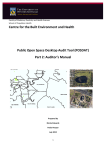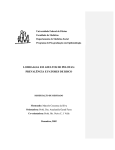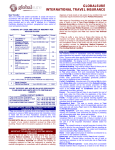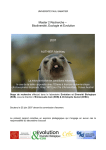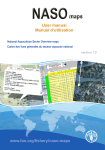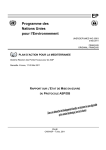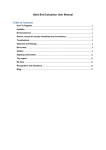Download Info pack, english
Transcript
OS2013-1 | UK Orca Saver Customer Information Pack 2013 ORCA SAVER First effective solution that protects your catch from orcas (killer whales). • Most effective solution available Protect your catch. Commander John Bortniak, NOAA Corps (ret.) • Easy to use for every dermersal longliner • An ecologically sustainable solution Keep orcas at a safe distance when hauling the line. SaveWave® SEALIFE SAVING TECHNOLOGY Content A. Introduction ........................................................................................................................................ 3 A1. Summary ....................................................................................................................................... 3 A2. Background ................................................................................................................................... 3 A3. Orca Saver ..................................................................................................................................... 4 A4. Performance.................................................................................................................................. 5 4.1 Testimonials............................................................................................................................... 7 B. Technical Data ..................................................................................................................................... 8 C. User Manual ...................................................................................................................................... 10 C1. Standard operating procedures .................................................................................................. 10 C1.1 Placing the Orca Saver under water ...................................................................................... 10 C1.2 Operating the Orca Saver ...................................................................................................... 12 C1.3 Retrieving the Orca Saver after hauling ................................................................................ 14 C2. Extra Information ........................................................................................................................ 15 C2.1 Orange electrical / data cable ............................................................................................... 15 C2.2 Transducers ........................................................................................................................... 16 C2.3 Storage .................................................................................................................................. 16 C2.3 Disposal ................................................................................................................................. 16 D. Warnings ........................................................................................................................................... 17 E. Environmental Responsibility ............................................................................................................ 19 E1. Introduction ................................................................................................................................. 19 E2. Extra Information ........................................................................................................................ 19 E3. Environmentally sustainable ....................................................................................................... 19 2 A. Introduction A1. Summary The Orca Saver is a highly innovative product, designed in close cooperation with fishermen to create an orca free safe zone around the hauling line. Killer whales (orcas) are well known for their thieving behaviour around longline vessels, taking all caught fish and creating enormous financial losses. The Orca Saver emits different signals under water that have been tested over recent years and have been found very effective by the fishermen using the product. On many occasions, within a few days their investment was already returned. A2. Background Killer whales are highly intelligent and opportunistic animals. They have learned through the years that longline vessels provide an easy meal for them and they actively search for these vessels to find this easy source of food. In some areas, for example around the Crozet Island, catches have been reduced by 75% due to whale depredation. This problem of depredation, the removal of fish from fishing gear, is currently increasing and occurs through all oceans and fisheries (Roche, et al., in CCAMLR Science 2007, vol. 14). Financial losses can be up to 30.000 dollars per fishing day. Killer whales are not the same animals around the world. There are three to five types of killer whales that may be distinct enough to be considered different races, subspecies, or possibly even a separate species. The following three types are already identified: Resident: These are the most commonly sighted of the three populations in the coastal waters of the northeast Pacific. Residents' diets consist primarily of fish and sometimes squid, and they live in complex and cohesive family groups called pods. Transient: The diets of these whales consist almost exclusively of marine mammals. Transients generally travel in small groups, usually of two to six animals, and have less persistent family bonds than residents. Transients roam widely along the coast; some individuals have been sighted in both southern Alaska and California. Offshore: A third population of killer whales in the northeast Pacific was discovered in 1988. As their name suggests, they travel far from shore and feed primarily on schooling fish, but they might also eat mammals and sharks. Offshores typically congregate in groups of 20–75. Next to this, three types have been documented in the Antarctic. Two dwarf species were described during the 1980s, but most cetacean researchers are skeptical about their status, and linking these directly to the types described below is difficult. 3 Type A looks like a "typical" killer whale, a large, black and white form with a medium-sized white eye patch, living in open water and feeding mostly on minke whales. Type B is smaller than type A. It has a large white eye patch. The white areas are stained slightly yellow. It feeds mostly on seals. Type C is the smallest type and lives in larger groups than the others. Like type B, it is primarily white and medium gray, with a dark gray dorsal cape and yellow-tinged patches. Its only observed prey is the Antarctic cod. Type D is immediately recognizable by its extremely small white eye patch, shorter than usual dorsal fin, and bulbous head. Its geographic range appears to be circumglobal in subantarctic waters between latitudes 40°S and 60°S. Although nothing is known about the their diet, it is suspected to include fish. Killer whales have the second-heaviest brains among marine mammals (after Sperm whales, which have the largest brain of any animal). They can be trained in captivity and are often described as intelligent. People who have interacted closely with killer whales offer numerous anecdotes demonstrating the whales' curiosity, playfulness, and ability to solve problems. For example, Alaskan killer whales have not only learned how to steal fish from longlines, but also have overcome a variety of techniques designed to stop them, such as the use of unbaited lines as decoys. Once, fishermen placed their boats several miles apart, taking turns retrieving small amounts of their catch, in the hope that the whales would not have enough time to move between boats to steal the catch as it was being retrieved. A researcher described what happened next: "It worked really well for a while. Then the whales split into two groups. It didn't even take them an hour to figure it out. They were so thrilled when they figured out what was going on, that we were playing games. They were breaching by the boats." —Craig Matkin Killer whales have good eyesight above and below the water, excellent hearing, and a good sense of touch. They have exceptionally sophisticated echolocation abilities, detecting the location and characteristics of prey and other objects in their environments by emitting clicks and listening for echoes. (Wikipedia) A3. Orca Saver As stated in the previous chapter, hearing and echolocation are very well developed senses in killer whales. To influence their behaviour, sound and ultrasound can be used. Based on research on the hearing of killer whales, the audiogram of killer whales has been identified (Szymanski et al.: Killer whale hearing in, J. Acoust. Soc. Am., Vol. 106) This means that we 4 know what frequencies killer whales are able to detect and at what frequencies their hearing is most sensitive. With this information, years of testing in close cooperation with fishermen has been conducted by SaveWave and Mustad Longline to determine the most suitable signals to influence the killer whale’s behaviour. These signals are emitted by the Orca Saver: a highly innovative product specifically designed to keep killer whales at a safe distance from longlining vessels to hauling in the catch. Therefore, the product must be placed underneath the fishing vessel with cables and as close to the hauling line as possible. The power by the emitted signals logically decreases over distance, so the closer to the line, the more effective. Turning the product on at least 15 minutes before hauling starts, gives the animals a chance to clear the area, making it possible to haul the line without orca interference. A4. Performance The Orca Saver is the most sophisticated and high-tech product on the market that has been especially designed to keep killer whales at a distance from fishing activity. The product is economically very attractive for the fishermen and in the mean time offers a solution that is ecologically safe and without negative impact. Its biological efficacy is an important point of attention. In biology there are many factors of influence on the final effect of a product. 100% efficacy simply does not exist in any kind of product that aims to solve a biological problem. Take for instance a simple pill of paracetamol that is used against pain. The efficacy of paracetamol varies greatly between individuals. There are many persons that feel little effect of it and then there are many that really NEED it. Kids may be more sensitive to paracetamol than adults and people with bowel problems may have little benefits. In general though, if paracetamol – or for that matter any kind of medication – reaches an efficacy level of 60 - 70 % then we have a very successful and useful medicine. The efficacy of the Orca Saver should be addressed from a similar perspective. Yes, the Orca Saver can indeed greatly reduce the killer whale problem and yes, the product offers great economic benefits: most of the fishing vessels using Orca Savers simply make a lot more money. However, that does not mean that the Orca Saver can solve the problem for 100% with all the killer whales in the world everywhere and under all conditions. Experiences with the Orca Savers that have been successfully deployed all over the world are very positive but have also showed on some occasions a decreased effect. For instance, the weather condition seem to play a role: with a lot of rain or in case of a very rough sea, it seems that the killer whales are less affected. This may be related to the fact that such conditions create an extreme amount of ambient sound which could reduce the 5 sound-contrast of the Orca Saver signal patterns. Especially in case of rough seas, the upper layers of the sea have a lot of little air bubbles. These air bubbles are greatly reducing the sound pressure (air is a good insulator for sound). So, in case of a rough sea we advice positioning the Orca Saver as deep as the cable allows, but no deeper than 20 meters. Situations have been reported in which certain animals do not seem to be affected at all while the other animals of the pod keep a long distance. This may have to do with individual sensitivity of the animals. Such sensitivity to extreme sound signals may have been reduced because the hearing of the animal has been affected by disease or under water explosions. In addition, the type of killer whale could be a factor as well. In waters with resident pods of killer whales, there have also been reports of some reduced efficacy. This may be related to the fact that those animals know the area very well and regard it as their territory and therefore refuse to be driven away by anything. There are many theories to explain why in some circumstances, in some areas or with some animals the Orca Saver seems to be less effective. It is a fact we must accept and that needs to be absolutely clear for the fishing vessel using the Orca Saver. One thing is for sure. Many situations in which lesser efficacy has been reported are directly related to the use of the Orca Saver in the WRONG way. The most common mistake is that the Orca Saver is only used and only switched on when the killer whales are already actively feeding from the line. Example: The lion and the goat. The Masai tribe in Africa often needs to protect their cattle from a lion. It is a well known fact that the lion can be scared away with a stick, some fire and noise. However, once the lion has grabbed its prey it will never let go. You can throw stones, hit it with a stick or stab it with a spear it will hold on and defend its food. With the killer whale it is very similar. Once the killer whale is already feeding on the line, it is much harder to scare it off and protect your catch. So our number 1 advice is: always turn on the Orca Saver before hauling the line when you expect some uninvited guests. The second mistake that is often made is that the Orca Saver is not positioned well. It is important that the Orca Saver hangs in a horizontal position and as close to the hauling line as possible. The front part of the Orca Saver with the most transducers must point towards the hauling line. This is the area that must be protected at all times. There are two ‘tips’ that have been reported to us. By tying an additional line to the back end of the Orca Saver, it sometimes is possible to ‘aim’ the front end of the product at the direction of a pod when this pod is swimming off the side of the vessel. Most sound pressure can be directed directly towards the killer whales in this way increasing efficacy. 6 Next to the killer whales (orcinus orca), the sperm whale is also “famous” for it’s interactions with longlines. We have received reports that the Orca Saver has also shown good results in keeping these animals at distance. 4.1 Testimonials The most extreme situation we have experienced is that one vessel lost approx. 20 full days of fishing due to the killer whales. Partly in lost catch, partly steaming away from the whales. An average catch value pr. day can be approx. USD 30.000. Using a lot of extra fuel and not catching any fish is seriously affecting the business. For sure, I can say, if the effect of the Orca Saver continues – I would not leave the port for fishing in this area without the Orca Saver onboard. Mr. Leif Petter Hoddevik Captain, F/V Argos Frøyanes, South Antartica. As an Alaskan longliner it's great to have a tool developed that responds to the increased whale predation on our world's fisheries. The Orca Saver has re-opened fishing opportunities and improved profitability once lost to whale predation. I'm grateful to the manufacturer for recognizing the need in developing tools that help our industry. Mr. Jim Hubbard Captain & Owner, F/V Kruzof, Alaska Screenshot of killer whales eating from a longline. 7 B. Technical Data Product characteristics: Weight: Approx 150 kg Dimensions: 90 x 45 x 35 cm Materials: Stainless steel, aluminium, ferrite, silver, electronics, rubber, plastic and different types of PU resin and silicone gel Different views of the Orca Saver. Sound: Transducers: 40 transducers (sound emitting parts) divided in 10 groups of 4 (2 groups more than 2012 version for more area coverage) Signals: Three different types of signals Output: 196 ± 2 dB re 1 μPa @ 1m Frequency: 6,5 kHz Pulse duration: 200 ms – 1,0 s 8 Signal characteristics: Three different type of signals: A) One second pulses; same signal as most effective signal in 2012 B) Short pulses on longer interval; acoustic startle effect C) Short pulses randomly selected on super short interval A) Two fixed groups of 4 transducers emit a one second pulse at 6,5 kHz, the most effective frequency. There is no off time and the duty cycle is 20%. This is the basic signal that was very effective in 2010, 2011 and 2012. B) Two fixed groups of transducers emit a short pulse of 6,5 kHz of a duration of 150-200 ms. Duty cycle differs per groups, but for all around 1 %. C) Two randomly addressed groups send out pulses of 200 ms. There is no off time and the duty cycle is 20%. Power characteristics: Inside the underwater unit there are 10 high power sonar amplifiers, each with a peak input power of approximately 6000 Watt. At the output of the sonar transformers we have a voltage of over 4000 Volt. At the 10 groups of 4 transducers this voltage is converted to pressure waves. 9 C. User Manual C1. Standard operating procedures Operating the Orca Saver must become a routine procedure onboard when hauling your longlines. It is therefore very important to read the following instructions and to work accordingly. C1.1 Placing the Orca Saver under water For operating the Orca Saver, a crane is needed because of the weight of over 150 kg. The Orca Saver is delivered with two holding cables with shackles to hang the Orca Saver underneath the vessel. Make sure that the part of the Orca Saver with the most transducers (orange round parts sticking out of the Orca Saver) is aimed towards the hauling line. Connect the central point of suspension of our provided holding cables to the cable on your crane. Lift the Orca Saver on deck first as a test to see that the cables are connected well and the Orca Savers weight indeed is supported by the cables. Always use a safety line as well. You do not want the Orca Saver sinking to the bottom because of a cable snapping. The Orca Saver must be placed on the same side as your hauling line and must be as close as possible to it for best results. The strength of the signals decrease over distance, so the closer to the line and/or the orcas, the better results you will have. The product is supplied with strong cables and shackles. The electrical cable must be tied to your main holding cable for the first meter. The electrical cable must have some slack here. There must never come any force on the orange electrical / data cable. Making sure that the electrical cable is tied to the main holding cable, the towing under water of the product will not create a heavy pressure on the tule (the point where the electrical cable is connected to the Orca Saver). When slowly lowering the Orca Saver to the desired depth, slowly feed the electrical cable by hand so it can run together 10 with the lowering of the product. Once again, make sure there is no pressure, stress, tension on the cable so give it slack. Not too much, because you do not want the cable to be pulled and pushed under water by the current. We advise placing the Orca Saver at 8-10 meters (8.5 – 11 yards) below the water surface. Trials have shown the best results placing it at this depth. Swell and waves create a layer of air bubbles of couple of meters in the surface. Placing the Orca less deep then 8-10 metres, the signals can be blocked in this layer. In very calm conditions, the product can be effective placing it around 6-7 metres. In very rough conditions, we advice positioning the Orca Saver as deep as the cable allows, but no deeper than 20 meters. Make sure that the Orca Saver is as horizontal as possible in the water for best results. If the products is not horizontal in the water, the transducers are not aiming in the right direction. Correct way of hanging the Orca Saver. 11 C1.2 Operating the Orca Saver The operating of the Orca Saver is done with the supplied control unit. Inside this box, the operating software communicates with the main controlling software inside the Orca Saver. The control unit must always be stored in a dry place. It must never come into contact with even the tiniest bit of water. Please install it in the captain’s wheel house. The electrical / data cable from the Orca Saver to the control unit is around 36 metres. Most important parts on the Control Unit. On the control unit, there is an ON / OFF switch. Turn it OFF. Then connect the Orca Saver to the control unit by connecting the connector plug on the long orange electrical / data cable into the opening in the control unit. There is only one right way for this and it is fairly easy. Just look at the connector on the cable closely and you will see how to fit it on the control unit. Place the cable connector plug on the connector opening on the control unit gently and turn the handle. Do not use too much force in this process. 12 Correct way of connecting the Orca Saver to the Control Unit. The control unit must then be connected to the normal power supply socket for the ACpower on deck. Connect it just like your computer. We supply two different types of electrical plugs to be used on board the ship, an European and an American. Use the one you need. Select a signal on the control unit by gently turning the selector. Make sure the Orca Saver itself is placed under water! Turn the ON / OFF switch to ON. After a few seconds, the Orca Saver starts emitting. It will always start with a safety test run before emitting the selected signal. This procedure will take less than 30 seconds in total. On the Control Unit there is a selection switch for 3 different signals. A, B, and C. A- Intensive signal with long pulses B- Acoustic Startle Reflex signal C- Intensive randomized signal with shorter omni-directional pulses 13 Signals can be selected on deck. Status light shows that the system is operating. We advise to use these signals as following: Always have the Orca Saver turned ON at least 15 minutes before hauling starts on signal A or C. Keep the Orca Saver turned on during complete hauling. These two type of signals send out continuously high output bursts of sound, that irritate the killer whales. If after a period of time, some killer whales might intend to come closer, switch the signal. You can switch the signals without turning OFF the Orca Saver. Changing between the signals takes approx 10 seconds. Do not switch back and forth between signals too fast! The Orca Saver sends out signals that are very annoying to killer whales. Therefore they keep a distance from the product and thus, the vessel. Since the line is the part that needs to be protected, place the Orca Saver always as close to the hauling line as possible. Next to this, it is of utmost importance to turn on the Orca Saver 15 minutes before hauling starts. Every time! Just like the killer whales have learned to feed from the lines, they must “ re-learn” to stay away from the vessel. You will not accomplish that by turning on the Orca Saver only once in a while for a few minutes. This will trigger their curiosity and they can habituate and adapt their strategy. The signals are designed to be used continuously. Never have the Orca Saver turned on above water. The transducers cannot transfer their energy above water and get damaged, which will result in a loss of output. C1.3 Retrieving the Orca Saver after hauling When the lines have been hauled and it is time to start setting again or sail/steam/go to a next line, take the Orca Saver out of the water. Do never keep the Orca Saver in water when you are not in the hauling process. The product behaves well under water by normal hauling 14 speed, but going faster, it will rise to the surface with forces/pressures that can be harmful to the cable and the product. Before taking the Orca Saver out of the water, turn OFF the control unit. Inform all the crew that the product is being hauled out of the water! Disconnect the plug on the orange power / data cable from the control unit and leave the end of the cable inside the captain’s cabin. The connector plug on the orange power / data cable must be kept completely dry at all times. Slowly retrieve the Orca Saver from the water with the same crane as you lowered the product with. Have a crewmember retrieving the orange power / data cable by hand at the same speed as withdrawal of the product. We advise having someone at the same time coiling up this cable as well. Once out of the water and above deck, lower it as slowly as possible. Handle the product with utmost care. It is as strong, durable and solid as possible, but always prevent it from bumping, shocking or dropping on deck. Lower it into the crate in which the product came, so it is stored safely. Make sure you do not place it onto the orange power / data cable. Hose off with fresh water. The crate must never be able to slide on deck because this will damage the transducers and possibly break the product. Make sure the cable does not affect the job of the crew onboard. Make also sure that crew cannot damage the cable when doing their normal job onboard. C2. Extra Information Some parts of the Orca Saver system deserve some extra attention. By addressing these points here, you will understand better how the complete system functions and why it is important to work according to this manual. C2.1 Orange electrical / data cable Like already mentioned, the most important detail for the electrical /data cable is SLACK. The cable provided is for electrical and data connections only. This cable cannot support the weight of the Orca Saver. Make sure tension or pressure on the electrical cable is avoided under all circumstances. Be as careful as possible with the cable. A small crack in the cable can break the complete product! Never have any weight on the cable itself, don’t step on it, do not place anything on it, make sure it does not come into contact with sharp objects etc. Be extra careful when placing the Orca Saver in the water. The cable must not be damaged by sliding over the railing of the ship for instance. Again, a crack can lead to water intrusion and shut down the complete product. Inspect the cable once in a while (every two weeks) for cracks or other damage. If found, contact us right away. 15 C2.2 Transducers The transducers (round orange parts) are the units from where the sound comes out of the Orca Saver. You can see them as the underwater speaker boxes for your sound system. They work together in groups of four to create the desired output. You must make absolute sure that they do not get damaged. Damage may reduce output and can lead to water intrusion. We have protected the transducers with stainless steel ribs but this does not mean by any means that they are unbreakable. So, like already mentioned, do handle the product with utmost care. C2.3 Storage When the Orca Saver is not in use, time being spend setting lines or steaming, store the Orca Saver on deck. Make sure that it is stored somewhere safe and in the crate it was supplied in. The crate must never be able to slide on deck because this will damage the transducers, possibly brake the product or can lead to dangerous situation onboard. Hose down the Orca Saver with fresh water after use so it is prevented from building up a salt layer. The salt can form a barrier on the transducers, decreasing signal power. The cable can best be stored on a reel. In this way, crew are not bothered by it working on deck and it is also safe form crew stepping on it or things falling on it. The control unit must always be in a dry place and preferably in the captain’s cabin / wheel house. Also when the product is not being used. The electronics inside this box cannot withstand water or frost, so keep it inside! The connector plug on the end of the orange power / data cable must also be kept dry at all times. It must never come into contact it water. So best is to keep it inside or protect it in a watertight cover. C2.3 Disposal Dispose the product, after its life span has run out, according to your local legislation. In many counties, the Orca Saver itself can be disposed of as “steal” or “building- and demolition waste/rubble”. The electrical cable and control unit must be disposed of as being “electronic waste”, just as your radio or computer for instance. 16 D. Warnings Keep these very important things in mind when using the Orca Saver. SaveWave and Mustad Longline are not responsible for the misuse of the Orca Saver. The Orca Saver can and must only be used according to our advice and for the purpose it has been designed for: keeping killer whales at a safe distance from longline vessels. 1. Only turn the Orca Saver on when it is IN the water. Shut it OFF before taking it out of the water. The electrical current running through the cable and the Orca Saver and Power Supply are enormous and dangerous: 4000 V! So never have the Orca Saver on above water. Transducers cannot transfer their energy above water and will get damaged. 2. Make sure that the weight of the Orca Saver is never carried by the electrical cable. It is there only to get the power and data to the Orca Saver and is not strong enough to carry the weight in or out of water. The electrical cable must have slack. 3. Do never have any weight on the orange power / data cable itself, don’t step on it, do not place anything on it, make sure it does not come into contact with sharp objects etc. Prevent damage on this cable at all times. 4. Use a safety line from deck to the Orca Saver, so that it can never be lost in case something goes wrong with the holding cable. Make sure (test that) the cables we supplied are strong enough to hold the Orca Saver. 5. Handle the product with care, although we made it as strong, durable and solid as possible. No bumping, shocking or dropping. 6. DO NOT OPEN the Orca Saver! Opening will cause damage to the electrical parts. It is fully casted with resin. Opening will also cause water intrusion, killing the product. Please note: 4000V may cause dangerous short circuit when damaged. 7. The control unit we delivered must ALWAYS be in a dry place. It must never come into contact with the least bit of water. Never open it. It is sealed with security seals, so Mustad Longline and SaveWave will notice opening. 9. Only use the Orca Saver for the problem we designed the product for. Keeping orcas / killer whales at a safe distance from hauling long lines. 17 10. Do not use the Orca Saver when human divers or swimmers are nearby. Divers and swimmers must be at least 10 kilometres away from the vessel. Also, don’t use the Orca Saver near whaling safaris. 11. If for some reason transducers or other parts are broken: Do not touch them! The 4000V will be very harmful to human life. If there are any doubts, questions or problems: contact Mustad Longline immediately and stop using the Orca Saver! 3D rendering of the Orca Saver 18 E. Environmental Responsibility E1. Introduction SaveWave is a small and dynamic Dutch company, specialized in the development of ecologically sustainable solutions to help fishermen and sea animals interact in the world's oceans. Every year dolphins, porpoises, tortoises and seabirds are hurt or die due to interactions with fishing gear. These animals sometimes end up unintentionally in fishing gear. Due to this negative interaction, some animal species are threatened. Our mission is to save these animals with solutions that are attractive for fishermen worldwide. We reach this objective through products that are acceptable from a biological sustainable point of view and at the same time being economically attractive for people and companies whose livelihoods depend on the seas. E2. Extra Information Longline fishing is a sustainable way of fishing, less destructive to bottom habitats and has good species selectivity and a low carbon footprint. One of the key problems in this manner of fishing is the thieving behavior of killer whales (orcas). When fishermen haul in their catch after a day’s fishing, the orcas gather underneath the fishing vessel where the hauled fish are taken. The fishing industry suffers enormous financial losses because of this thieving behavior. Many whales are hurt by this interaction when they get too close to the vessel. Moreover, orcas get accustomed to this unnatural fishing behavior and lose their natural fishing instinct, making future interactions more likely. They will become dependent on the fast food industry longlining is becoming for them. These reasons are why SaveWave has developed the Orca Saver together with Mustad Longline, our partner in this project. We have tested several prototypes in different locations worldwide. After consulting with the fishermen, biologists and technical experts, SaveWave has now produced the newest series of Orca Savers for 2013. E3. Environmentally sustainable Since SaveWave is a “green” company, we will never develop products that are harmful to the environment. One of our products, Vibe-Lite, is even developed to stop the enormous environmental impact of light sticks used in long lining. All of our other products and projects are for keeping sea mammals safe. SaveWave has gained a good name in this field and partnerships with WWF and Dolphin Fund are good examples of our philosophy. The decibel levels we use in the Orca Saver are well beneath the signals that sperm whales themselves produce (above 200 dB) and well beneath levels of sonar equipment trialed by US Navy (far above 200 dB). Even more, our signals are emitted at higher frequencies then 19 that of the Navy’s for instance, making sure the signals decrease in power faster over distance. One of the comments on the Orca Saver was: “When the OS unit was activated, the killer whales slowly swam away (Froyanes)” The slow backing up is not a reaction that indicates that the killer whales are harmed in any way. The ships have observers from MRAG onboard and we have never had any signs that our product might be harmful. Furthermore, for other projects we work closely together with the WWF and ACCOBAMS. Therefore we cannot (and by our philosophy will not!) develop products causing harm to animals whatsoever. Observers have seen orcas “stay” at a couple of hundred meters from the vessel when the product was turned on during hauling, indicating that the sound of the Orca Saver does not bother them at that distance. In 2010, SaveWave received funding from the Dutch government as part of a call for preservation of biodiversity. SaveWave was selected from over 100 companies that signed up. This once more shows that SaveWave is a company with a mission to save sea life, in which environmental organizations, our government and fishermen truly believe. 20




















